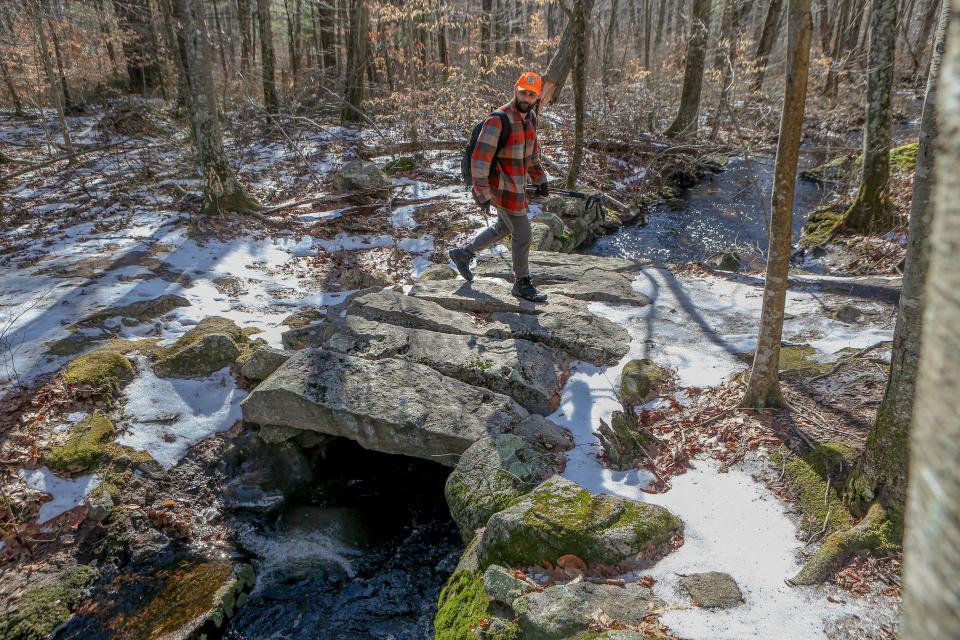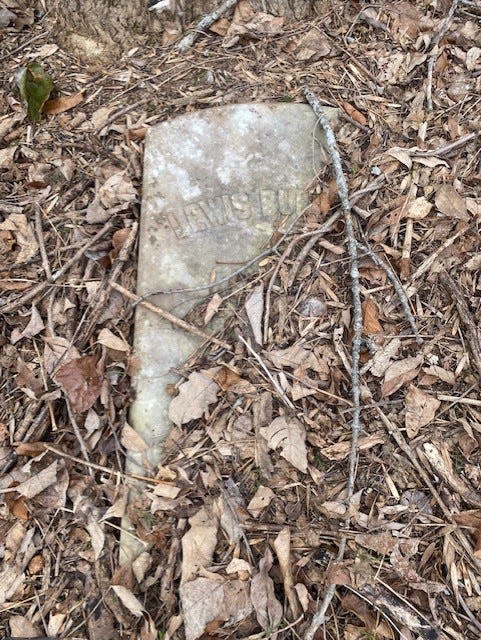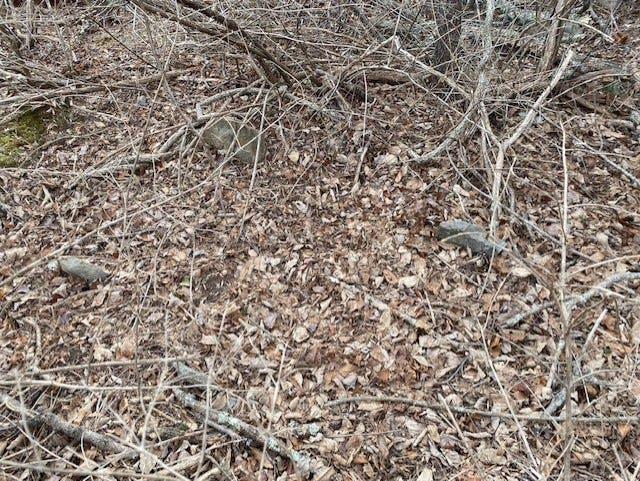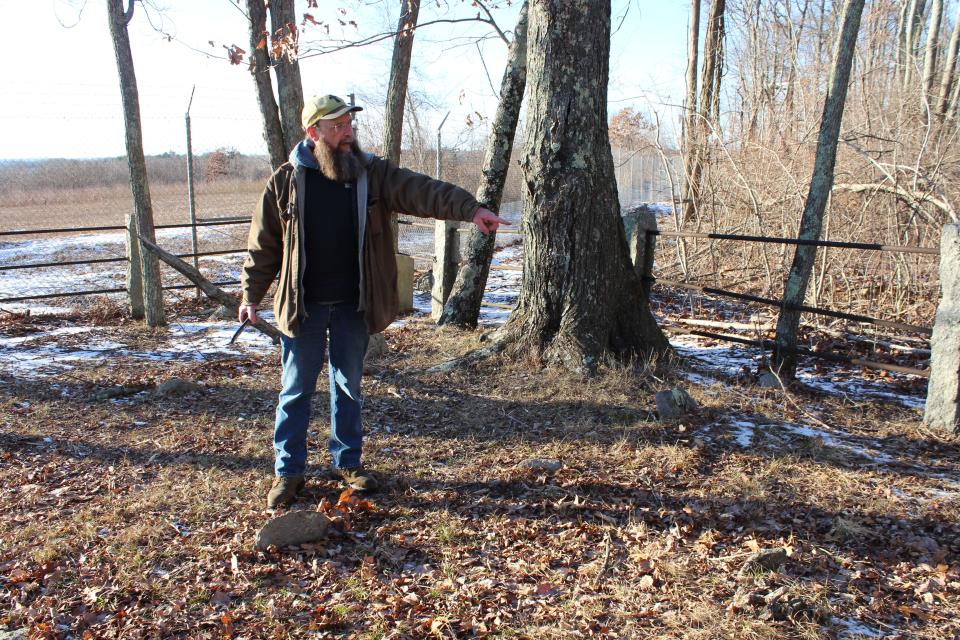Once lost, this rediscovered Cranston burial plot may hold a Revolutionary War veteran
CRANSTON – Hiking through John L. Curran State Park this month, Andrew Grover rediscovered a historical cemetery, overgrown and littered, that may hold the remains of a Revolutionary War soldier from Rhode Island.
Now Grover, his friend and the chairman of the Cranston Historical Cemeteries Commission want to clean up the small plot, find out who's buried there, mark it with a sign and get it properly documented in city and state records.
"These old places in the woods of Rhode Island, these old stone walls, these old cemeteries, really speak to me," Grover said. "It means a lot to me to be in these places. They're very beautiful. They're more than beautiful. They're sacred."
More:Army with weedeaters is sought to clean up 12-acre Cranston cemetery

Rhode Island has hundreds of small, historical burial plots
Grover's discovery offers a peek into a unique part of Rhode Island's history. In the 1800s and earlier, farmers and other property owners would bury family members in plots on their own land. Rhode Island has hundreds, maybe thousands, of such cemeteries sprinkled across its landscape.
Some of these historical cemeteries are still visible and sit close to businesses, highways and houses. Some have been run over by development. Others have been lost to time, their stones swallowed by the earth and covered by brush as forest took back farmland.
An avid hiker, Grover, 43, came across the historical cemetery Sunday, Feb. 5, after walking a couple of miles across the state park. Having checked land records and using an app to help with his location, Grover thought he might find an old cemetery, but it wasn't easy.
Buried in trash:Cranston cemetery has become an illegal dumping ground. What can be done?
More:Whatever happened to Monkeytown, RI … both of them?
Winding his way from east to west past the John L. Curran Lower Reservoir, Grover found the cemetery "hiding in plain sight." It wasn't far off a path, but it was protected and hidden by thick, thorny brush that Grover had to fight through.
"I got myself inside, which was not easy," Grover said. "I was surprised nobody really found this before, but I'm not surprised."
Inside, he found an area about the size of a one-car garage, surrounded by a stone wall. He believes six or more bodies could be buried there. He also found trash.
Was it a lost cemetery?
Grover, his friend The Rev. Ken Postle, a historical cemetery preservationist, and John Hill, chairman of the Cranston Historical Cemetery Commission, are trying to determine whether Grover rediscovered a "lost" cemetery, one that's listed in a state database as an "unknown lot."
The Rhode Island Historical Cemeteries Commission has a vast database of cemeteries. Most of the listings, organized numerically, include detailed information on facts such as the location, and the names of the people buried there, but in the commission's listing for Cranston, at least nine are listed as "unknown" lots.
"This is one that's lost. It's considered unknown," said Postle, a Baptist minister. "We haven't been able to find it."
More:Boston Tea Party rebels and shipwrecked souls rest here. The ocean had other ideas, though.

Grover said on Twitter, "It seems to be the 'lost' Cranston 576."
The best information on Rhode Island's historical cemeteries comes from the work of a genealogical researcher named James Newell Arnold, who traveled Rhode Island in the late 1800s and early 1900s, documenting Colonial-era cemeteries. In July of 1891, Arnold visited a cemetery that may prove to be the same one that Grover rediscovered. In the state database listing for CR576, an "unknown lot," is the following note: "James Arnold visited this lot 12 Jul 1891 (Vol 2, Pg 249) On the farm lately owned by Owen Burlingame on the north side of the brook, a burial yard in which at present nothing but rude markers remain. A portion of the interments have been taken up and removed elsewhere, neglected and unprotected."
The land where Grover found the cemetery is now owned by the state, but Owen Burlingame had owned a lot of land in the area many years before. But perhaps the strongest clue linking the cemetery to "lost" Cranston 576 came after Arnold's visit. Grover found and photographed a partially obscured headstone that he believes marks the grave of Lewis Burlingame, who died Jan. 29, 1892.
If Burlingames owned the property, it makes sense that family members would be buried there, according to Postle. That Lewis Burlingame was buried there could also mean his grandfather James Burlingame Jr., a Revolutionary War captain, could be buried there, Postle said.

"If he's here, we'll put a marker with a flag. Anyone who visits the site will know there's a veteran buried there and it's hallowed ground," Postle said.
Hope that the cemetery will be cleaned up
Grover may play a key role in rediscovering the cemetery and linking it to Arnold's work, but researchers don't have to go all the way back to Arnold in the 1800s to find somebody who's been there. In 2018, Cranston resident Jan Ragno snapped a photograph of the same headstone that Grover would photograph six years later.
Although she lives nearby on Hope Road, Ragno didn't know about the forgotten cemetery until she was told by a friend named Betty Thurne, then 97 and a wealth of information on Cranston history. Thurne, now deceased, told Ragno where to find the old cemetery and Thurne's son, Alvin, escorted her there. Ragno posted a photograph of the Burlingame headstone on the Find A Grave website, but nobody connected the dots to the "lost" Cranston 576 plot.
Ragno also hopes the cemetery can get cleaned up and marked with a sign.
"These people have been buried and forgotten once," she said. "I don't want it to happen again."
Postle and Hill have spent a lot of time cleaning up historical cemeteries, Postle in the Blackstone Valley, Hill in Cranston. Over the last two years, the Cranston Historical Cemeteries Commission has managed to clean up about a half-dozen cemeteries, according to Hill. In most cases, after the cleanups, neighbors have agreed to keep up with ongoing maintenance, he said.
"If there's a cemetery, we feel it needs to be treated with respect," Hill said.

Postle would like to get a group to the cemetery in early March to clean it up and see what else they can learn about who's buried there. Getting equipment and people to the site could be tricky. Grover purposely took a long route to the cemetery through a distant entrance in the park, and there are closer access points but the closest access points might require permission to cross through yards.
"These are people created in the image of God," Postle said, "and that's why I'll go out and look for these folks."
Postle is excited by Grover's discovery, or rediscovery, and what historical secrets the cemetery might yield.
"We have lost a lot of cemeteries to development. I count this one as a win, no matter what state it is in now," Postle said. "I think there are a lot more waiting to be discovered still."
This article originally appeared on The Providence Journal: Historical Cranston RI cemetery may hold Revolutionary War soldier

